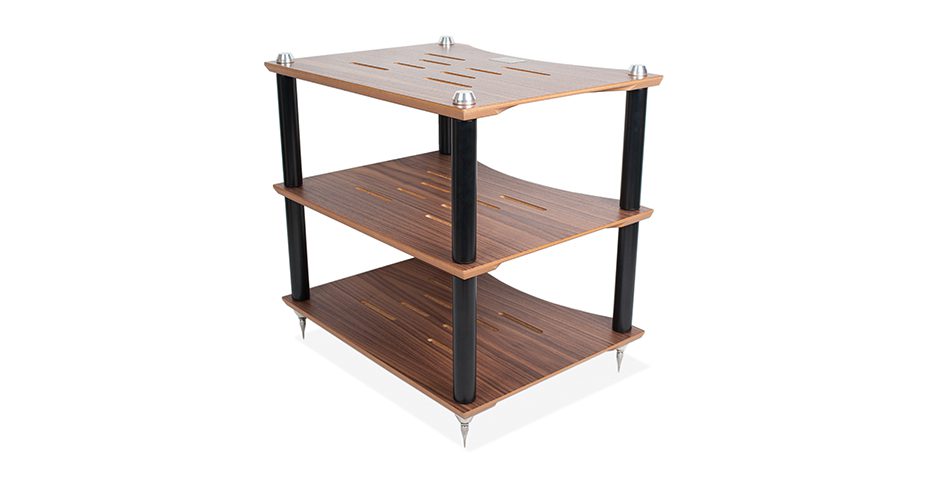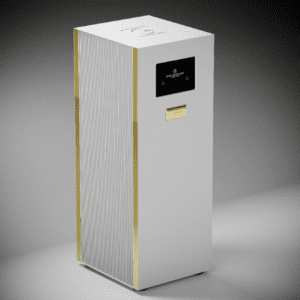
Audio equipment stands are slaves to two masters: decorative aesthetics and sonic performance. These two aspects are often thought of as directly opposing one another; the sonically excellent – but brutal-looking – home oil rig vs. the refined wood, leather and glass audio furniture that underperforms in the sound department. Lateral Audio Stands is one of the rare exceptions that straddles the great divide between ‘how it sounds’ and ‘how it looks.’
Lateral Audio Stands’ range of audio supports and stands are no strangers to these pages; the company’s top-tier LAS-4 stand being reviewed here, and the simpler, entry-level LAS-9 Cadenz here. The LAS-9 Cadenz Vr is, you’ll not be surprised to read, a development of that latter model. The ‘Vr’ bit denotes the use of wood veneers to the visible surface of the stands, the better to cover the ‘how it looks’ bit, but other changes to the design merit a re-visit.
Design and construction
The basic design from the LAS-9 Cadenz carries over: crisply machined high-quality fibre board shelves clamped between thin-walled tubular steel uprights with Delrin end caps. This means the surfaces that bear on the shelves benefit from the Delrin’s absorbing and insulating capabilities, which are better to minimise energy transmission into and between the various levels. It’s a doddle to put together, and the spiked feet are threaded and thus offer a levelling facility.
The review unit was supplied with the optional Counterpoint spikes, which have locking nuts with hex flats, so they can be securely nipped up once adjusted to level. The actual uprights don’t have to be tightly fastened; finger tight is plenty secure and allows the Delrin to do its job as intended. The review unit also came with matching floor protector shoes; helpful on our wooden floor and for keeping me out of the doghouse.
The main difference, wood veneer aside (the finish of which is excellent and worth the extra on aesthetic grounds alone), is that the machined grooves that form Lateral Audio’s ‘dissipation array’ are more complex in nature and are worked into both the top and bottom surfaces. This means one set of grooves is visible from the top, cutting through the full depth of the shelf, with additional, shallower grooves machined into the underside. The idea is to break up vibration modes and disrupt the propagation of vibrations through the stand. Overall, the lasting impression is of a thoughtfully worked-out design, nicely implemented and well finished off.
Lateral Audio charges the same, per tier, regardless of the height of the columns you specify, and there are four height options, ranging from 120mm to 280mm, which should accommodate a wide range of equipment. As AS noted in issue 199, the LAS-9 Cadenz is a stand scaled to match the lower and midrange parts of the equipment market and priced very competitively. The additional complexity and finish of the Cadenz Vr takes the concept further upmarket. However, still some way below the higher end LAS-4, which makes it a reasonable proposition for customers with more expensive equipment but who aren’t in the ‘you could fund a space mission for that much!’ league.
I used the Cadenz Vr with my regular Accuphase DP570 and E-480 combination, a pairing that is closer to the LAS-4’s fare. No pressure, then. Moreover, although these two models don’t tend to display ‘The Princess and the Pea’ tendencies, they are not insensitive to their surroundings. Many equipment support systems I’ve used have, shall we say, failed to impress. Some, I’d even go so far as to say they broke the music.
The Lateral Audio Stands Cadenz Vr didn’t break the music. The timing stayed tight and toe-tapping, dynamics were decidedly decent, pitch and tonality were precise and tuneful. Patricia Barber’s ‘Hunger’ from Mythologies [Blue Note] starts with vocal and electric guitar singing and playing in unison. The Cadenz Vr showed that the guitar also follows the vocal very closely in terms of pace, phrasing and intonation; it’s not an accompaniment or a dialogue, it’s mimicking Barber’s voice. It’s critical to the opening, and easily glossed over. So, we’re fundamentally in a good place.
Youn Sun Nah, the extraordinary Korean jazz vocalist, sings a slightly unsettling version of ‘My Favourite Things’ on Same Girl [ACT]. Accompanied only by a strangely disturbing glockenspiel (it’d have earned The Sound of Music a 15 rating back in the day) it’s so effective because of that incongruity. And that comes through well enough to achieve the desired effect. This is also perhaps where the difference between the Cadenz Vr and stands like the LAS-4 begin to show; there’s a subtle blurring between each crystalline glockenspiel note, while on ‘Pancake’ from the same album, her vocal articulation doesn’t quite reach the heights I know she’s capable of. Still, the energy and timing of the piece remain tight and enjoyable.
On the floor
But here’s a thing, I’ve heard similar, adverse effects on loudspeakers using metal floor protectors, and in removing them, the blur around the glockenspiel was much reduced. Ms Na’s articulation took on another level of subtlety and poise. However, this is very much a ‘Your Mileage May Vary’ moment. This was interesting because it suggests the stand has real promise.
I’m an inveterate audio tweaker; you aren’t trying hard enough if it doesn’t have an array of cones, pods, pads, or pucks. But such tweaks rely on a good foundation, and the Lateral Audio Stands Cadenz Vr is a good foundation for ‘normies’ who want a damn good stand and for those of us obsessive-compulsives who view excellent equipment support as a launch pad. Encouraged by this, I tried a few other tweaks. Now ‘The Hours’ backing choir (from the same Patricia Barber Mythologies album) had form and structure, and imaging and soundstage were more solid and stable; Iiro Rantala’s ‘January’ from My Finnish Calendar [ACT] had a richly dark and sonorous piano; ‘February’ regained its carefree playfulness. Vikingur Olafsson’s account of Philip Glass’ Etudes [DG] reminded me why his interpretation had completely changed my views on the merits of Glass as a composer, and why this disc is rarely far from hand.
Those nuanced aspects of performance are baked into the performance of the Lateral Audio Stands Cadenz Vr. Otherwise, they wouldn’t be possible to be teased out by my hours of tweaking. And to most people, they probably don’t need to go too far down the hot-rodding line to achieve the same performance levels. But, regardless of whether you are wired in the same way as I am, the Lateral Audio Stands Cadenz Vr is a good solution. That speaks to rare flexibility in stand design; often, equipment stands that offer good performance fail to play nice with the other kids; by sounding so intrinsically right out the starting gates and responding well to tweaks, the Cadenz Vr not only straddles the divide between ‘looks good’ and ‘sounds good’, but also brings some degree of rapprochement between ‘fit and forget’ and ‘just one more cone…’.
Lessons learned
There are some valuable lessons here: notably that the stand/floor interface can be at least as important as the stand itself, but also that the LAS-9 Cadenz Vr Lateral Audio Stands has itself a product which will not only do justice to an inexpensive system as My First Hi-Fi Stand™ but has the potential to raise its game as your hardware improves. Yes, somewhere down the line, the stand may become a limiting factor, but that may be further on the journey than you first expect, because here is a stand which allows you to exploit the potential of tweaks and upgrades to system support, without the pressing need to replace the underlying structural element to realise those benefits. No blind alley this.
There’s always a concern when a company comes up with a ‘tweener’ product. It can be the top model pared back too far, or the entry-level design ‘pimped up’ out of all proportion. This isn’t simply a concern for stand makers or audio companies. It applies universally, but Lateral Audio Stands gets it right. The Cadenz Vr sits perfectly between the company’s entry and top stand and is a worthwhile addition to the portfolio. It’s well worth trying out!
Technical specifications
- Lateral Audio LAS-9 Cadenz Vr modular equipment rack
- External dimensions (mm): 600(w) × 455(d)
- Internal platform size (mm): 500(w) × 360(d) (to inside edge of uprights)
- Leg/spacer height options: 120; 160; 220; 280
- Weight capacity (per shelf): 30Kg
- Price 2-Tier £595; £200 per additional tier
- Counterpoint spikes £95
- Counterpoint spikes and floor protector shoes £125
- Finishes
- Standard Oak; Black Oak; Maple
- Extra cost Walnut (add £20, per shelf)
Manufacturer
Lateral Audio Stands
By Steve Dickinson
More articles from this authorRead Next From Review
See all
PrimaLuna EVO 100 phono preamplifier
- Apr 22, 2024

Reiki Audio SuperSwitch Master Pro + Servant Pro
- Mar 27, 2024

Melco Audio N1-S38 music server
- Mar 27, 2024











